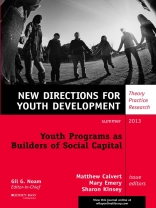This volume builds understanding of practices in youth and community development that create or build social capital assets at the individual, group, and community levels. The authors explore whether programs contribute to the development of social capital at the individual and community scales, thereby fostering and enhancing positive youth development as well as community development.
It includes articles on defining and measuring social capital through instruments designed to document impact and also to engage program participants. The authors then discuss program practices that build social capital in a wide range of youth development settings, from community-based service-learning to 4-H community clubs. Finally, they focus on building social capital in particular contexts, including work in rural communities with the most vulnerable youth.
The volume is designed to help practitioners:
* Refine their dual focus on youth and community development
* Clarify constructs that help translate the public value of positive youth development to community stakeholders
* Provide examples of practices that link youth and youth programs more intentionally to the social relationships that knit communities together.
This is the 138th volume of New Directions for Youth Development, the Jossey-Bass quarterly report series dedicated to bringing together everyone concerned with helping young people, including scholars, practitioners, and people from different disciplines and professions.
Tabla de materias
Issue Editors’ Notes 1
Matthew Calvert, Mary Emery, Sharon Kinsey
Executive Summary 9
1. Social capital: Its constructs and survey development15
Richard P. Enfield, Keith C. Nathaniel
Developing a strategy for measuring social capital among youthclarifies the construct and practice.
2. Measuring social capital change using ripple mapping 31
Barbara Baker, Elaine M. Johannes
Ripple mapping can help youth envision the impact of developingsocial capital.
3. Social capital and youth development: Toward a typology ofprogram practices 49
Mary Emery
This article presents a typology of youth programming relatedto opportunities to develop social capital.
4. Using multiple youth programming delivery modes to drive thedevelopment of social capital in 4-H participants 61
Sharon Kinsey
4-H activities exemplify methods to build social capital.
5. A community development approach to service-learning:Building social capital between rural youth and adults 75
Steven A. Henness, Anna L. Ball, Mary Jo Moncheski
Community service-learning supports the building of socialcapital between youth and adults.
6. Social capital and vulnerability from the family, neighborhood, school, and community perspectives 97
Bonita Williams, Suzanne M. Le Menestrel
This article provides examples of how the development of socialcapital can benefit vulnerable youth.
7. Engaging underrepresented youth populations in communityyouth development: Tapping social capital as a critical resource109
Nancy Erbstein
An intentional focus on social capital in community initiativesfacilitates the engagement of underrepresented youth.
8. Engaging young people as a community development strategy inthe Wisconsin Northwoods 125
William Andresen, Margaret Dallapiazza, Matthew Calvert
This article describes strategies to make communities morehospitable to young people in order to reverse the brain drain andincrease community vibrancy.
Index 141
Sobre el autor
Matthew Calvert and Mary Emery are the authors of Youth Programs as Builders of Social Capital: New Directions for Youth Development, Number 138, published by Wiley.












